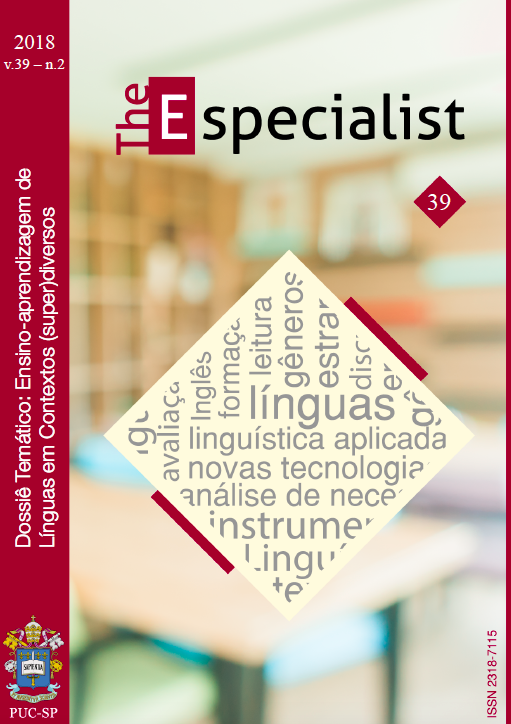MOBILIDADE, PAISAGENS DIGITAIS E PRÁTICAS (TRANS)LINGUÍSTICAS
DOI:
https://doi.org/10.23925/2318-7115.2018v39i2a6Keywords:
Paisagem Linguística/Semiótica, Translinguismo, Sujeito, Mídias digitaisAbstract
O presente trabalho propõe discutir, a partir de uma perspectiva dialogicamente orientada, possíveis articulações entre os conceitos de Paisagem Linguística / Semiótica, ambientações digitais e a noção de mobilidade e suas implicações para o engajamento em práticas linguísticas contemporâneas. Entendendo-se a língua(gem) como prática social e historicamente situada, torna-se premente examinar (trans)formações decorrentes dos deslocamentos tempo-espaciais que contextualizam comunicações discursivas pautadas em propiciações (affordances) decorrentes de interações situadas no ciberespaço. Ademais, torna-se pertinente analisar possíveis implicações para o ato de “tornar-se” (no sentido bakhtinianamente proposto) do sujeito ao engajar-se em práticas comunicativas contextualizadas e(m) mídias digitais.
References
AZZARI, E. F. 2017a. Discursos sobre a presença de tecnologia em aula de inglês na educação básica: abismos e pontes. 2017, 239 p. Tese (Doutorado em Linguística Aplicada). Instituto de Estudos da Linguagem, Universidade Estadual de Campinas, Campinas.
_____________. 2017b. Articulações possíveis entre manifestações em paisagens linguístico-semióticas no ciberespaço e (uma) educação linguística crítica. In: ROCHA, C. H. et al. Diálogos sobre tecnologia educacional: educação linguística, mobilidade e práticas translíngues. Campinas: Pontes, p. 59 - 91.
AZZARI, E. F.; R. de MELO.2016. Olhares sobre a linguagem em redes sociais e suas interfaces com a educação crítica e pluralista. In: Texto livre, linguagem e tecnologia. Belo Horizonte: Periódicos UFMG, vol.09, n. 2, p. 94-113, jul-dez.
BAKHTIN, M./VOLOCHÍNOV, V. N. 2006. Marxismo e filosofia da linguagem. 12. ed. São Paulo: Hucitec.
BAKHTIN, M. 1981. Discourse in the novel. In : HOLQUIST, M. (ed). The dialogic imagination – four essays. Austin: The University of Texas Press. Translated by Caryl Emerson and Michael Holquist
____________. 2011. Estética da criação verbal. 6a ed. Tradução de Paulo Bezerra. São Paulo: Editora Martins Fontes.
¬____________. 2015. Teoria do Romance I: A estilística. Tradução, prefácio, notas e glossário de Paulo Bezerra. Organização da edição russa de Serguei Botcharov e Vadim Kojinov. São Paulo: Editora 34.
BLOMMAERT, J. 2016. "Meeting of Styles" and the online infrastructures of graffiti. In: Applied Linguistics Review, vol. 7, issue 2,jun.
______________. 2015. Chronotopes, scales and complexity in the study of language in society. In: Annual Review of Anthropology . Tilburg Papers in Culture Studies, paper 121. Disponível em: http://www.annualreviews.org/doi/abs/10.1146/annurev-anthro-102214-014035. Acesso em 20 maio 2017.
BLOMMAERT, J.; MALY, I. 2014. Ethnographic Linguistic Landscape Analysis and social change: a case study. In: Working papers in Urban language & Literacies. London: King´s College.
CANAGARAJAH, S. 2013. Translingual Practice – Global Englishes and Cosmopolitan Relations. New York: Routledge.
CASTELLS, M. 2016. A sociedade em rede. Vol.1. (17a ed. revista e ampliada). Tradução de Roneide Venancio Majer. São Paulo: Paz e Terra.
____________. 2012. Netwoks of outrage and hope – social movements in the internet age. Maiden: Polity press.
IVKOVIć, D. 2012. Landscapes, linguascapes, and linguistic mediation in cyberspace. Disponível em: https://www.academia.edu/21744068/Landscapes_linguascapes_and_
linguistic_mediation_in_cyberspace. Acesso em: 20 maio 2017.
JAWORSKI, A.; THURLOW, C. 2011. Semiotic Landscapes. Language, Image, Space. London / New York: Continuum.
JENKINS, H. 2011. Transmídia 202: Further reflections. Disponível em: < http://henryjenkins.org/2011/08/defining_transmedia_further_re.html> Acesso em 20 ago 2017.
MACHADO, I. 2001.Digitalização. Linguagem. Discurso. As mediações dialógicas possíveis. In: Lumina, v.4, no. 2, p.19-48, jul./dez. Juiz de Fora: Facom/UFJF.
McLUHAN, M. 2006. A energia híbrida: Les Liaisons Dangereuses. In: Os meios de comunicação como extensões do homem (3a Ed). Tradução de Décio Pignatari. São Paulo: Cultrix, p.67-75.
MANOVICH, L. 2005. Novas mídias como tecnologia e ideia: dez definições. In: LEÃO, L. (org.) O chip e o caleidoscópio – reflexões sobre as novas mídias. São Paulo: Editora SENAC, p. 23-50.
SANTAELLA, L.2011. Linguagens líquidas na era da mobilidade. 2 ed. São Paulo: Paulus.
VITANOVA, G. 2013. Authoring the Self in a non-native language: a dialogic approach to agency and subjectivity. In: HALL, J. K. et al. 2013. Dialogue with Bakhtin on Second and Foreign Language Learning – new perspectives. New York: Routledge, p.149-169.
WELLMAN, B. et al. 1996. “Computer networks as social networks: collaborative work, telework and virtual community”, In: Virtual Reviews of Sociology, n. 22, p. 213-238.
Downloads
Published
How to Cite
Issue
Section
License
The authors grant the journal all copyrights relating to the published works. The concepts issued in signed articles are the absolute and exclusive responsibility of their authors.


 Esta obra está licenciada com uma Licença
Esta obra está licenciada com uma Licença 